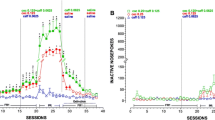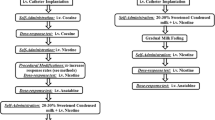Abstract
Several recent studies have shown that caffeine potentiates the reinforcing, discriminative stimulus, and motor activating effects of cocaine in rats. The present study was designed to determine whether oral caffeine pretreatment would enhance the reinforcing effects of cocaine in rhesus monkeys trained to self-administer smoked cocaine base. The effects of oral caffeine pretreatment (0, 100, or 200 mg) and fixed-ratio (FR) value on cocaine-base smoking were evaluated in four male rhesus monkeys. Monkeys responded on a lever under a fixed-ratio (FR) schedule (FR 128, 256, 512, 1024, 2048, or 4096) and then made five inhalations on a smoking spout to gain access to volatilized cocaine base (0.25 or 1.0 mg/kg per delivery) during daily experimental sessions. Twenty pellets [20 non-caffeinated (0 mg caffeine), ten non-caffeinated+ten caffeinated (100 mg caffeine), or 20 caffeinated (200 mg caffeine) pellets] were administered 30 min prior to experimental sessions. The lever FR value was held constant within each experimental session, but was increased after 3 consecutive days of stable responding. Although the number of smoke deliveries that was self-administered significantly decreased from FR 128 to FR 4096, it did not change as a function of cocaine dose across the range of FR values tested. However, the interaction between cocaine dose and caffeine pretreatment was statistically significant. Compared to 0 mg caffeine, three of four monkeys pretreated with 200 mg caffeine responded for a greater number of smoke deliveries when they were maintained on a cocaine dose of 1.0 mg/kg per delivery, but not 0.25 mg/kg per delivery. Thus, caffeine pretreatment can produce small, but statistically significant increases in smoked cocaine self-administration in rhesus monkeys.
Similar content being viewed by others
References
Carroll ME, Boe IN (1984) Effect of dose on increased etonitazene self-administration by rats due to food deprivation. Psychopharmacology 82:151–152
Carroll ME, Krattinger KL, Gieske D, Sadoff DA (1990a) Cocaine-base smoking in rhesus monkeys: reinforcing and physiological effects. Psychopharmacology 102:443–450
Carroll ME, Stitzer ML, Strain E, Meisch RA (1990b) The behavioral pharmacology of alcohol and other drugs. Recent Dev Alcohol 8:5–46
Comer SD, Hunt VR, Carroll ME (1994) Effects of concurrent saccharin availability and buprenorphine pretreatment on demand for smoked cocaine base in rhesus monkeys. Psychopharmacology 115:15–23
Comer SD, Turner DM, Carroll ME (1995) Effects of food deprivation on cocaine base smoking in rhesus monkeys. Psychopharmacology 119:127–132
Derlet RW, Tseng JC, Albertson TE (1992) Potentiation of cocaine and d-amphetamine toxicity with caffeine. Am J Emerg Med 10:211–216
Fernstrom JD, Fernstrom MH (1984) Effects of caffeine on monoamine neurotransmitters in the central and peripheral nervous system. In: Dews P (ed) Caffeine. Springer, New York, pp 107–118
Gauvin DV, Harland RD, Michaelis RC, Holloway FA (1989) Caffeine-phenylethylamine combinations mimic the cocaine discriminative cue. Life Sci 44:67–73
Gauvin DV, Criado JR, Moore KR, Holloway FA (1990) Potentiation of cocaine's discriminative stimulus effects by caffeine: a time-effect analysis. Pharmacol Biochem Behav 36:195–197
Griffiths RR, Woodson PP (1988) Reinforcing properties of caffeine: studies in humans and laboratory animals. Pharmacol Biochem Behav 29:419–427
Harland RD, Gauvin DV, Michaelis RC, Carney JM, Seale TW, Holloway FA (1989) Behavioral interaction between cocaine and caffeine: a drug discrimination analysis in rats. Pharmacol Biochem Behav 32:1017–1023
Holtzman SG (1986) Discriminative stimulus properties of caffeine in the rat: noradrenergic mediation. J Pharmacol Exp Ther 239:706–714
Horger BA, Wellman PJ, Morien A, Davies BT, Schenk S (1991) Caffeine exposure sensitizes rats to the reinforcing effects of cocaine. Neuro Report 2:53–56
Johanson CE, Schuster CR (1981) Animal models of drug self-administration. Adv Subst Abuse 2:219–297
Lau CE, Ma F, Falk JL (1990) Simultaneous determination of cocaine and its metabolites with caffeine in rat serum microsamples by high-performance liquid chromatography. J Chromatogr 532[1]:95–103
Misra AL, Vadlamani NL, Pontani RB (1986) Effect of caffeine on cocaine locomotor stimulant activity in rats. Pharmacol Biochem Behav 24:761–764
Rall TW (1985) Central nervous system stimulants: The methylxanthines. In: Gilman AG, Goodman LS, Rall TW, Murad F (eds) Goodman and Gilman's the pharmacological basis of therapeutics. Macmillan, New York, pp 589–603
Robertson D, Curatolo PW (1984) The cardiovascular effects of caffeine. In: Dews P (ed) Caffeine. Springer, New York, pp 77–85
Schenk S, Horger B, Snow S (1990) Caffeine preexposure sensitizes rats to the motor activating effects of cocaine.Behav Pharmacol 1:447–451
Schenk S, Valadez A, Horger BA, Snow S, Wellman PJ (1994) Interactions between caffeine and cocaine in tests of self-administration. Behav Pharmacol 5:153–158
Tuazon DB, Suzuki T, Misawa M, Watanabe S (1992) Methylxanthines (caffeine and theophylline) blocked methamphetamine-induced conditioned place preference in mice but enhanced that induced by cocaine. Ann NY Acad Sci 654:531–533
Worley CM, Valadez A, Schenk S (1994) Reinstatement of extinguished cocaine-taking behavior by cocaine and caffeine. Pharmacol Biochem Behav 48:217–221
Author information
Authors and Affiliations
Rights and permissions
About this article
Cite this article
Comer, S.D., Carroll, M.E. Oral caffeine pretreatment produced modest increases in smoked cocaine self-administration in rhesus monkeys. Psychopharmacology 126, 281–285 (1996). https://doi.org/10.1007/BF02247378
Received:
Accepted:
Issue Date:
DOI: https://doi.org/10.1007/BF02247378




